URBANREC
Compositional Characterization of Different Industrial White and Red Grape Pomaces in Virginia and the Potential Valorization of the Major Components
To better evaluate potential uses for grape pomace (GP) waste, a comprehensive chemical composition analysis of GP in Virginia was conducted. Eight commercial white and red pomace samples (cv. Viognier, Vidal Blanc, Niagara, Petit Manseng, Petit Verdot, Merlot, Cabernet Franc, and Chambourcin) obtained from different wineries in Virginia, USA were used. For extractives, GPs contained 2.89%–4.66% titratable acids, 4.32%–6.60% ash, 4.62%–12.5% lipids with linoleic acid being the predominant (59.0%–70.9%) fatty acid, 10.4–64.8 g total phenolic content (gallic acid equivalents)/kg GP, 2.09–53.3 g glucose/kg GP, 3.79–52.9 g fructose/kg GP, and trace sucrose. As for non-extractives, GPs contained 25.2%–44.5% lignin, 8.04%–12.7% glucan, 4.42%–7.05% xylan, and trace amounts of galactan, arabinan, and mannan (less than 3% in total). Potential usages of these components were further examined to provide information on better valorization of GP. Considering the valuable extractives (e.g., polyphenols and oil) and non-extractives (e.g., lignin), designing a biorefinery process aiming at fully recover and/or utilize these components is of future significance.

» Author: Qing Jin
» Reference: doi: 10.3390/foods8120667
» Publication Date: 11/12/2019
» More Information

This project has received funding from the European Union's Horizon 2020 research and innovation program under grant agreement Nº 690103




URBANREC Guidelines by URBANREC Consortium is licensed under a Creative Commons Reconocimiento-NonComercial-NoDerivatives 4.0 Internacional License.
Puede hallar permisos más allá de los concedidos con esta licencia en www.aimplas.net
